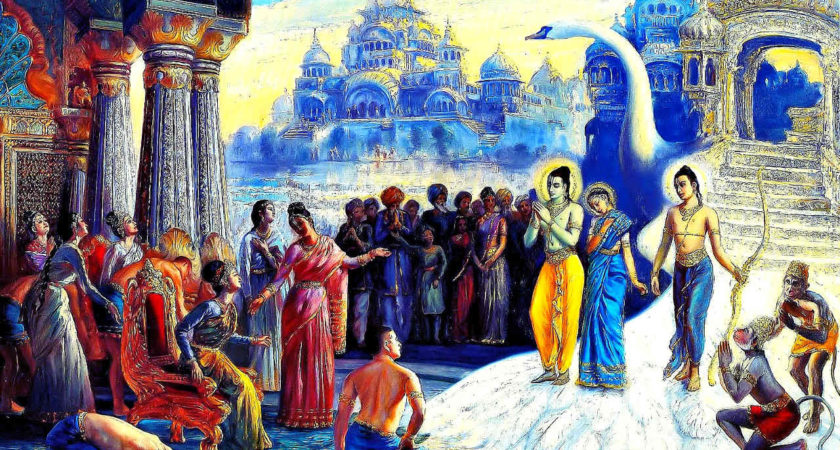The two well-known Itihasas (histories) are the epics (Mahakavyas), Ramayana and Mahabharata. They are two very popular and useful Sastras of the Hindus. The Ramayana was written by the sage Valmiki, and the Mahabharata by Vyasa.
The common man cannot comprehend the high abstract philosophy of the Upanishads and the Brahma Sutras. Hence, the compassionate sages Valmiki and Vyasa wrote the Itihasas for the benefit of common people. The same philosophy is presented with analogies and parables in a tasteful form to the common run of mankind.
The Ramayana and the Mahabharata speak to us clearly about the ancient India, about her people, her customs, her ways of living, her arts, her civilisation and culture, her manufactures, etc. If you read these two books, you will come to know how great India once was, and you will be inspired to make her great once more. No other country has produced so many great men, great teachers, great Yogins, great Rishis, great prophets, great Acharyas, great kings, great heroes, great statesmen, great patriots and great benefactors, as India. The more you know of India and Hinduism, the more you will honour and love it and the more thankful to the Lord you will be that you were born in India as a Hindu. Glory to India! Glory to Hinduism!
THE RAMAYANA
The Ramayana, the Adi-Kavya or the first epic poem, relates the story of Sri Rama, the ideal man. It is the history of the family of the solar race descended from Ikshvaku, in which was born Sri Ramachandra, the Avatara of Lord Vishnu, and his three brothers. The ideal characters like Rama, Sita, Lakshmana, Bharata and Sri Hanuman that we find in Ramayana firmly establish Hindu Dharma in our minds. The story of the birth of Rama and his brothers, their education and marriages, the exile of Sri Rama, the carrying off and recovery of Sita, his wife, the destruction of Ravana, the Rakshasa King of Lanka, and the reign of Sri Rama, are described in detail in Ramayana. How a man should behave towards his superiors, equals and inferiors, how a king ought to rule his kingdom, how a man should lead his life in this world, how he can obtain his release, freedom and perfection, may be learnt from this excellent epic. The Ramayana gives a vivid picture of Indian life. Even today our domestic, social and national ideals are copied from the noble characters in the Ramayana and the Mahabharata. The great national heroes stand even today as beacon-lights to guide and inspire the people of the whole world. The lives of Rama, Bharata and Lakshmana provide a model of fraternal affection and mutual service. Sri Hanuman stands as an ideal unique Karma Yogin. The life of Sita is regarded as the most perfect example of womanly fidelity, chastity and sweetness. The Ramayana is written in twenty-four thousand verses by Sri Valmiki.
THE MAHABHARATA
The Mahabharata is the history of the Pandavas and the Kauravas. It gives a description of the great war, the Battle of Kurukshetra, which broke out between the Kauravas and the Pandavas who were cousins and descendants of the lunar race. The Mahabharata is an encyclopaedia of Hindu Dharma. There is really no theme in religion, philosophy, mysticism and polity which this great epic does not touch and expound. It contains very noble moral teachings, useful lessons of all kinds, many beautiful stories and episodes, discourses, sermons, parables and dialogues which set forth the principles of morals and metaphysics. The Pandavas obtained victory through the grace of Lord Krishna. The Mahabharata is written in one hundred thousand verses by Sri Krishnadvaipayana Vyasa.
THE BHAGAVAD-GITA
The most important part of the Mahabharata is the Bhagavad-Gita. It is a marvellous dialogue between Lord Krishna and Arjuna on the battle-field, before the commencement of the great war. Bhagavan Sri Krishna became the charioteer of Arjuna. Sri Krishna explained the essentials of Hindu religion to Arjuna. Just as the Upanishads contain the cream of the Vedas, so does the Gita contain the cream of the Upanishads. The Upanishads are the cows. Lord Krishna is the cowherd. Arjuna is the calf. The Gita is the milk. The wise men are those who drink the milk of the Gita.
The Gita is the most precious jewel of Hindu literature. It is a universal gospel. The Gita teaches the Yoga of Synthesis. It ranks high in the religious literature of the world.
Arjuna saw before him his dear relatives and teachers in the battle-field. He fainted and refused to fight against them. Then Lord Krishna imparted knowledge of the Self to Arjuna and convinced him that it was his duty to fight regardless of consequences. Afterwards Arjuna gave up his Moha, or delusion. All his doubts were cleared. He fought against the Kauravas and achieved victory.
Current Program
Valmiki Ramayana Classes during Holidays at Vedagurukula

